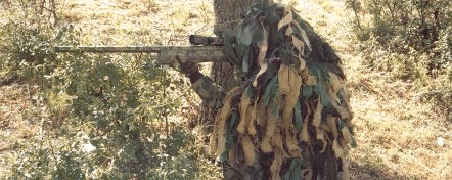|
|
|
|
|
|
|
|
|
Ghillie Suits
|
|
|
|
|
|

|
|
|
|
|
|
|
The ghillie suit's history begins during the 19th century in Scotland, where it was used by land-owners to capture poachers. Similar suits were used during the First and Second World Wars, however, in these conflicts camouflage was not a widely used practice, both among common soldiers and snipers. The first known unit to use ghillie suits were the British Lovat Scouts' Snipers, who came across the suits in Scotland.
|
|
|
|
|
|
|
|
|
|
|
The ghillie suit today is a specially made camouflage uniform which is given an irregular pattern and outline by the attachment of many pieces of garnish to a netting affixed to the base. The base is usually either a set of combat BDUs or a one-piece aviator type uniform. The suit is sometimes turned inside out so that the pockets are on the inside and protected from damage caused by crawling during stalking. The front is covered with a thick canvas or cloth to reinforce the front, and padding covers the knees and elbows for added comfort and to prevent being worn-out.
|
|
|
|
|
|
|
|
|
|
|
A piece of netting is sewed on to the back of the base. It is to this netting that strips of garnish are tied onto. This garnish comes in the form of colored burlap or torn cloth from BDUs, socks, etc. The color of this garnish must match the area the suit will be worn in. The garnish should be between one to two feet long and should completely cover the back, legs, and arms. While lying in the prone position, the garnish should reach down to the ground and cover most of the boots. A bush hat is "ghillied" in the appropiate manner, with enough garnish to cover the scope but not hinder vision. A veil can be sewed around the brim of the hat to cover the face.
|
|
|
|
|
|
|
|
|
|
Natural vegetation must be added to the suit for it to be completely effective. The vegetation can be tucked into the netting. However, the ghillie suit does not make someone completely invisible and special care must be taken when wearing the suit. The suit, because of its garnish, is a fire hazard and must be treated with a fire-retardant. Also, the suit can become extremely hot and bulky, so if it is to be used in high tempatures the sniper must do everything to avoid dehydration and fatigue. The ghillie suit also takes a lot of time to construct, and the materials needed can be hard to find.
|
|
|
|
Ghillie Suit Tips
My Personal Ghillie Suit Construction
Pics of My Own Suit-New 7/29/98!!!
|
|
|
